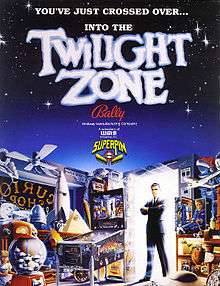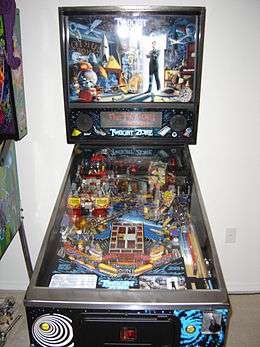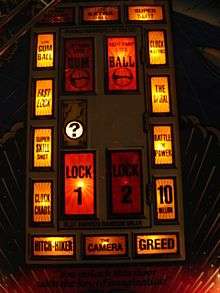Twilight Zone (pinball)
 | |
| Manufacturer | Midway |
|---|---|
| Release date | April 1993 |
| System | Midway WPC (Fliptronics II) |
| Design | Pat Lawlor, Larry DeMar, Ted Estes |
| Programming | Larry DeMar, Ted Estes |
| Artwork | John Youssi |
| Mechanics | John Krutsch |
| Music | Chris Granner |
| Sound | Chris Granner, Rich Karstens |
| Voices | Tim Kitzrow (Rod Serling) |
| Production run | 15,235 |
Twilight Zone is a widebody pinball machine, designed by Pat Lawlor and based on the TV series of the same name. It was first released in 1993 by Midway (under the Bally label). This game is part of WMS' SuperPin line of widebody games alongside Star Trek: The Next Generation and Indiana Jones: The Pinball Adventure.[1]
Description

Following the huge success of The Addams Family pinball game, Midway gave Lawlor full creative control over the design of his next game, and the result is an unusually complex machine. Among its noted features include a working gumball machine (which deposits balls), a working analog clock (used as a timer for various modes), the Powerfield (a small separate play field where the ball is propelled by magnets rather than flippers), and the "Powerball", a white ceramic ball which is lighter than a regular steel ball and is non-magnetic.
In addition to adapting the theme music from the original TV show, the game's main background music is an interpretation of the 1982 hit "Twilight Zone", by Golden Earring. Tim Kitzrow provided the voice of Rod Serling.[2]
This game was originally supposed to be the first game to use Williams / Midway's DCS Sound System, but because the DCS board was still in development when the game was released, it instead used the Yamaha YM2151 / Harris CVSD sound board.
Twilight Zone is currently the top-rated electronic pinball machine of all time on the Internet Pinball Machine Database.[3]
Connections to the TV series
The Twilight Zone pinball machine is filled with references to its namesake TV show. These references include, but are not limited to:
- The door from the opening credits takes up most of the center of the playfield, and its sections are labelled with each of the game's modes.
- The blonde-haired artist's mannequin from the opening credits appears on the left slingshot.
- The zodiac clock from the opening credits appears as an actual, functioning clock on the playfield, which can show the current time and also act as a timer for various modes.
- An image of Henry Bemis from the episode "Time Enough at Last", appears next to the "slot machine" cellar hole.
- The hitch-hiker from the episode of the same name appears on the playfield, and as a collectible bonus.
- A slot machine used in "The Fever" and "The Prime Mover" appears on the playfield, labelling a cellar hole that triggers a slot machine animation on the DMD and starts a random mode.
- The camera from "A Most Unusual Camera" appears in front of a cellar hole (behind the upper left flipper) that can give various awards.
- The tiny spacemen from "The Invaders" make several appearances in DMD animations.
- The radio from "Static" plays during a multi-ball mode.
- The player piano from "A Piano in the House" labels a cellar hole that can start modes.
- Talky Tina from the episode "Living Doll" appears in the Extra Ball DMD animations.
- Robby the Robot, who appeared in the episodes "Uncle Simon" and "The Brain Center at Whipple's" is featured on the playfield and in a DMD animation.
- Various sound effects are taken from the episodes listed above, and several quotes from Serling's voice-overs are featured, including "You unlock this door with the key of imagination" from one of the show's opening sequences.
Additionally, many more Twilight Zone references appear in the translite artwork.
Oddly, two of the most prominent features of the game – the gumball machine and "The Power" – do not appear in the TV series at all.
Door Panel Modes
In the center of the Twilight Zone playfield artwork is a door similar to the one shown in one of the TV show's opening sequences. The door consists of 14 border panels indicating various awards that are available for the player to collect. Some of the panels start single-ball or multi-ball timed modes that can be "stacked" (started while other modes are in progress), while other panels simply light shots or award points. The ultimate goal of the game is to light all fourteen panels and start "Lost in the Zone", the game's "wizard mode", represented by the doorknob.
The game provides several ways to light door panels: Shoot the Slot Machine when lit, shoot the Player Piano when lit, or defeat the Power in the mini-play field. Shooting the Slot Machine awards a random unlit door panel, while the other two methods award the door panel that is currently flashing (rotated by the pop bumpers).
The door panels are as follows:
- 10 Million Points – Awards 10 million points. Can also be collected if a player makes a yellow Skill Shot or any Super Skill Shot.
- Lite Gumball – Lights the Gumball machine. The player must shoot the right orbit to load the current ball in play into the gumball machine.
- Town Square Madness – Starts a timed mode in which all targets on the playfield increase a point total by a set amount, while the pop bumpers in Town Square increase the value for each target and cause townspeople to panic.
 Door panels in attract mode
Door panels in attract mode - Fast Lock – An AM radio plays clips from Pat Lawlor's previous pinball games, counting down a jackpot value as its "frequency". Shooting the Lock awards the current jackpot value and starts a three-ball multiball mode, where shooting the Lock awards the jackpot again. The background music played during this multi ball is the main multi ball music from the game whose clip was most recently played in single-ball mode. The games referenced are, in order, The Addams Family, FunHouse, Whirlwind, Earthshaker!, and Banzai Run.
- Super Skill Shot – Lights the Super Skill Shot. Shooting the left ramp causes the ball to return to the plunger, where the player must then make a skill shot to score special bonuses: Red lights "Battle the Power", Orange lights the outlanes, and yellow lights "Extra Ball". Attempting the shot awards 10 million points, whether the player earns an award or not.
- Super Slot – Timed mode. Each shot to the Slot Machine awards a random point value (10-20 million).
- Lite Extra Ball – Lights "Extra Ball," which must be collected by shooting the Lock. Under the default settings, receiving an extra ball by any means will automatically mark this panel as "collected".
- The Camera – Lights the Camera. Shooting the Camera yields one of eight awards: "20 Million Points", "Lite Outlanes", "Clock 10 Millions", "Collect Bonus", "3X Town Square", "Hold Town Square", "10 Hitchhikers", and "Greed Targets". In normal play, the offered award remains the same from player to player, and from game to game, until it is collected. The Camera must go through all eight awards before it can offer any of them again; when the last award of the eight is collected, the Camera will not immediately offer it again.
- The Spiral – Timed mode. Shooting the orbits causes the ball to stop on the Spiral magnets for the first three shots (10/10/15 million), then awards 15 million "Breakthrough" points for each subsequent shot as the ball goes through the loop.
- Clock Millions – Timed mode. Shooting the clock target (between the two ramps) awards 1 million points times the position of the hour hand on the clock. (A similar mode, "Clock 10 Millions", is started via the Camera and awards 10 million points per hit, regardless of the hour hand's position.)
- Battle The Power – Lights the "Battle the Power" shot on the right ramp. Shooting the right ramp when this is lit starts "Battle the Power" mode, if the player is not using the Powerball at the time.
- Greed – Timed mode. All of the 5-million-point targets start lit.
- Hitch-Hiker – Awards 2 million points for each hitchhiker the player has picked up thus far in the game. Each additional hitchhiker picked up during the player's current ball scores another 2 million points.
- Clock Chaos – Timed mode. The clock starts at 6:00 and begins running backwards, playing "Pop Goes the Weasel" throughout the mode. Hitting the clock target awards 1 million points times the position of the hour hand, and the clock reverses direction and starts counting faster. The mode ends when the clock reaches 12:00. If the target is hit enough times (somewhere around 7) Rudy from 'Fun House' says "Quit playin' with the clock!"
The one single-ball mode not accounted for by the door panels is "Battle the Power". The door panel by the same name merely lights the right ramp. To actually play the "Battle the Power" mode, the player must shoot the right ramp when the shot is lit and the Powerball is not in play. The ball moves to the raised triangular mini-playfield (the "Powerfield") at the left edge of the main playfield, and the player must then direct the ball into the top hole within a set time limit. The Powerfield utilizes two medium-power magnets that act as flippers (dubbed "Magna-Flips"). Points are awarded for hitting switches on the walls. If the ball falls through the bottom hole or time runs out, the player scores the points accumulated during the mode. If the player succeeds in shooting the ball through the top hole, the total is doubled and the currently highlighted door panel mode is started. (This will start "Lost in the Zone" if all door panels have been started.)
Since the Powerball is unaffected by magnets, the game will automatically disable Battle the Power whenever it senses that this ball is on the field. Shots to the right ramp will be dropped in front of the upper left flipper. If the player lights Battle the Power, that ramp will light once normal single-ball play resumes.
Multi-ball
In addition to the multitude of single-ball modes, Twilight Zone also offers four multi ball modes:
- Standard Multiball (3-ball) – Started when the player locks two balls in the Lock, then either shoots the Lock a third time or (in some cases) shoots the left ramp. Jackpots are awarded for shooting the Player Piano when lit, and are re-lit by shooting the Camera. The player can increase the jackpot value by hitting the flashing 5-Million targets. If the Powerball is shot into the Player Piano, a double jackpot is awarded. On normal settings, the player can start this multiball for the first time by shooting the left ramp after locking one ball, but the jackpot's starting value will be reduced.
- Powerball Mania (3-ball) – Started when the player successfully loads the Powerball into the Gumball Machine. The player may "Battle the Power" simultaneously while making other shots on the main playfield, and is awarded a 50-million-point jackpot for successfully defeating the Power.
- Fast Lock Multiball (3-ball) – See the description in single-ball modes.
- Lost in the Zone (6-ball) – The game's wizard mode, awarded for successfully lighting all of the door panels. The doorknob (bearing a question mark) becomes lit, and any of the normal mode-starting shots will start this mode. The player has approximately 45 seconds to make an unlimited number of shots to all targets – every playable single-ball mode, including Battle the Power, is active during this period, and balls are immediately put back into play when they are lost. Once time runs out, all targets and flippers go dead and all balls are allowed to drain. The total score is tallied while the machine refills the Gumball Machine, cycling the balls so that the Powerball goes in last. Gameplay then returns to normal.
Note: In most commercially released machines, the Standard Multiball mode starts with three balls being released sequentially from either the Lock or the auto plunger, depending on how many balls are physically contained in the Lock at the time. An alternative start to this mode is available in some versions of the ROM software, and requires that a third magnet be installed in the Spiral orbit (standard machines only have two magnets). This allows the machine to lock all three balls in the Spiral Magnets and then release them simultaneously.
Digital versions
Twilight Zone is available as a licensed table of The Pinball Arcade for several platforms. Unlicensed recreations of the game are available for Visual Pinball and Future Pinball that run on Windows.
References
- ↑ http://www.ipdb.org/machine.cgi?id=2684
- ↑ IGN.com - Breaking into the Industry: Tim Kitzrow. Retrieved on 12 October 2008.
- ↑ Top 300 IPDB Rated Pinball Machines
External links
- IPDB listing for: The Twilight Zone
- Twilight Zone on Pinside.com
- Pinpedia Database Entry: The Twilight Zone
- Twilight Zone mods
- Twilight Zone promo video
- Twilight Zone Owners Community
- The GameRoom Blog: Romancing The Twilight Zone Pinball, by Ted Estes
- The GameRoom Blog: The Twilight Zone Pinball: Prototype vs. Production, by Ted Estes